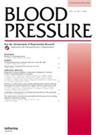肥胖与心脏重构中MMP-9之间的串扰——一项对明显治疗难治性高血压的横断面研究
IF 2.3
4区 医学
Q2 PERIPHERAL VASCULAR DISEASE
引用次数: 12
摘要
基质金属蛋白酶(MMP)及其组织抑制剂(TIMP)之间的平衡在高血压和肥胖的发展中起着关键作用。我们的目的是评估肥胖和非肥胖明显耐药高血压受试者(aTRH)中MMP-2和9以及TIMP-2和-1的水平及其与心肌肥大的关系。这项横断面研究纳入了122名受试者,并将其分为肥胖aTRH(n = 67)和非肥胖(n = 55)组。比较两组的临床和生化数据,包括办公室血压、动态血压、血浆MMP-2和9、TIMP-2和1以及左心室质量指数(LVMI)。我们发现肥胖aTRH受试者的MMP-9水平和MMP-9/TIMP-1比率较高,但MMP-2和TIMP-1水平没有差异。肥胖影响MMP-9水平[β = 20.8 SE=8.6,p = 0.02)独立于潜在的混杂因素。此外,我们发现MMP-9与拟人参数呈正相关。最后,患有左心室肥大(LVH)的肥胖aTRH受试者与患有LVH的非肥胖受试者相比,MMP-9水平更高。我们的研究表明,MMP-9水平受到肥胖的影响,并可能直接参与进行性左心室重塑过程,这表明在明显耐药的高血压受试者中,MMP-9的水平可能在更高的心血管风险中发挥作用。本文章由计算机程序翻译,如有差异,请以英文原文为准。
Crosstalk between obesity and MMP-9 in cardiac remodelling –a cross-sectional study in apparent treatment-resistant hypertension
Abstract The balance between matrix metalloproteinases (MMP) and their tissue inhibitors (TIMP) plays a key role in the development of hypertension and obesity. We aimed to evaluate the levels of MMP-2 and 9 and TIMP-2 and -1 in obese and non-obese apparent treatment-resistant hypertensive subjects (aTRH) and its association with cardiac hypertrophy. This cross-sectional study enrolled 122 subjects and divided into obese aTRH (n = 67) and non-obese (n = 55) group. Clinical and biochemical data were compared between both groups, including office BP, ambulatory BP, plasma MMP-2 and 9, TIMP-2 and 1 and left ventricular mass index (LVMI). We found higher MMP-9 levels and MMP-9/TIMP-1 ratio in obese aTRH subjects but no difference in MMP-2 and TIMP-1 levels. Obesity influenced MMP-9 levels [β = 20.8 SE =8.6, p = 0.02) independently of potential confounders. In addition, we found a positive correlation between MMP-9 and anthropomorphic parameters. Finally, obese aTRH subjects with left ventricular hypertrophy (LVH) had greater MMP-9 levels compared with non-obese with LVH. Our study suggests that MMP-9 levels are influenced by obesity and may directly participate in the progressive LV remodelling process, suggesting a possible role for a higher cardiovascular risk in apparent resistant hypertensive subjects.
求助全文
通过发布文献求助,成功后即可免费获取论文全文。
去求助
来源期刊

Blood Pressure
医学-外周血管病
CiteScore
3.00
自引率
5.60%
发文量
41
审稿时长
6-12 weeks
期刊介绍:
For outstanding coverage of the latest advances in hypertension research, turn to Blood Pressure, a primary source for authoritative and timely information on all aspects of hypertension research and management.
Features include:
• Physiology and pathophysiology of blood pressure regulation
• Primary and secondary hypertension
• Cerebrovascular and cardiovascular complications of hypertension
• Detection, treatment and follow-up of hypertension
• Non pharmacological and pharmacological management
• Large outcome trials in hypertension.
 求助内容:
求助内容: 应助结果提醒方式:
应助结果提醒方式:


